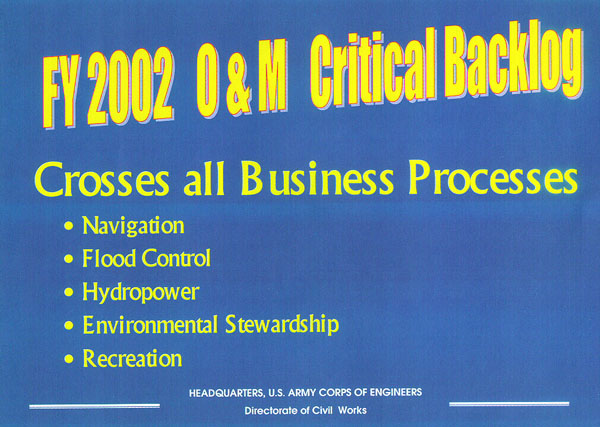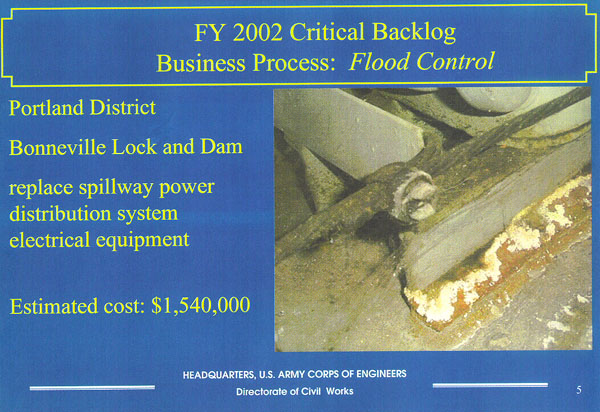
MR. CHAIRMAN AND MEMBERS OF THE SUBCOMMITTEE: I am honored to be testifying to your subcommittee today, along with the Deputy Assistant Secretary of the Army (Management and Budget), Ms. Claudia L. Tornblom, on the President's Fiscal Year 2002 (FY02) Budget for the United States Army Corps of Engineers' Civil Works Program.
I am proud of my association with this program, first as a field engineer and research project manager for the Portland District, then as commander of the Mississippi River Valley Division, and, since October, as Chief of Engineers. I am especially honored to have the opportunity to lead the Corps through its current challenges to serve this great nation in meeting its many water and related land resources management needs.
Thanks to this subcommittee's support, the Civil Works Program remains strong, balanced, responsive, and highly productive. I look forward to working with you in furtherance of our partnership in prosecuting this fine program, so broadly beneficial to our nation.
In this statement, I will focus on significant challenges for the nation in water and related land resources management. I will say just a few words about the budget, then devote the balance of my testimony to an assessment of national water and related land resources management needs. Accordingly, my statement covers just these two topics:
* Summary of the Civil Works Program Budget, and
* Assessing the Nation's Needs for Water and Related Land Resources Management.
SUMMARY OF CIVIL WORKS PROGRAM BUDGET
Introduction
This is a good budget. New funding for the Civil Works Program, including the Direct and Reimbursed programs, is expected to approach $5.11 billion.
As shown in Table 1, Direct Program funding, including discretionary and mandatory amounts appropriated directly to the Corps, totals $4.41 billion. Discretionary amounts total $3.90 billion; additional amounts total $514 million.
Reimbursed Program funding is projected to be $700 million.
Direct Program
The proposed budget reflects the Administration's commitment to continued sound development and management of the nation's water and related land resources. It provides for continued efficient operation of the nation's navigation, flood protection, and other water resource management infrastructure, fair regulation of the nation's wetlands, and restoration of the nation's important environmental resources, such as the Florida Everglades. It is consistent with the President's overall domestic priorities and continued commitment to a balanced budget.
The budget provides for continued funding of nearly all studies and projects underway, including many started in FY01. It also provides for funding of two new starts under the General Investigations (GI) program.
Reimbursed Program
Through the Interagency and Intergovernmental Support Program we help non-DOD federal agencies, States, and other countries with timely, cost-effective implementation of their programs, while maintaining and enhancing capabilities for execution of our Civil and Military Program missions. These customers rely on our extensive capabilities, experience, and successful track record. The work is principally technical oversight and management of engineering, environmental, and construction contracts performed by private sector firms, and is fully funded by the customers.
Currently, we provide reimbursable support for about 60 other federal agencies and several State and local governments. Total reimbursement for such work in FY02 is projected to be $700 million. The largest share - nearly $270 million - is expected from the Environmental Protection Agency (EPA) for cleanup of wastes at numerous sites under its Superfund program. 90% of Reimbursed Program funding is provided by other federal agencies.
ASSESSING THE NATION'S NEEDS FOR WATER AND RELATED LAND RESOURCES MANAGEMENT
Introduction
Water and related land resources play major roles in how Americans live and work. There are many competing and conflicting demands on use of these limited resources. When, where, how, to what extent, by whom, and by what means should the demands be addressed? Over the years, the Corps has employed various means to gather information for use in defining and understanding national water and related land resource management issues. Recently, it has employed "Listening Sessions" to improve the accuracy, currency, and relevancy of its information.
Initial Assessment of Circumstances
Last year, through assessment of trends and results of research, literature searches, and consultations with selected water and related land resource management experts, we concluded that the nation is facing important water and related land resources management challenges with serious implications. We made the following observations and interpretations:
* As the world's climate changes, changing hydrology and water distribution and, in turn, environmental and socioeconomic conditions, we must anticipate need for changes in and additions to the nation's water and related land resources management facilities, systems, and practices, and effect such changes as opportunely as feasible.
* As global markets expand, international commerce will demand more efficient domestic ports and harbors, and improved vessel and intermodal cargo handling facilities.
* With many properties and major populations located in the nation's floodplains, flooding will continue to threaten national welfare. Moreover, as pressures continue to develop, flood-prone lands and natural flood management systems will be compromised, and the threat of flood damage will increase.
* Ongoing migration of the nation's population to coastal plains and coasts, and attendant property development, will increase risks of loss from coastal erosion, floods, and hurricanes.
* The ongoing migration to coastal plains and coasts will put increasing pressure on coastal habitat, especially wetlands, and other fish and wildlife ecosystems.
* Through Water Resources Development Acts of 1996 and 1999 (WRDA 96 and WRDA 99), the American public placed national environmental health in the forefront of social priorities. These acts, providing additional authorities to the Corps for ecosystem and watershed protection and restoration, increase emphasis on national need for ecosystem restoration, wetlands management, and nonstructural floodplain management.
* As the nation's water and related land management infrastructure ages, it must be rehabilitated, modified, replaced, or removed.
* As the nation's population grows, there will be growing conflicts among multiple interests within watersheds wanting to use available water and related lands for diverse needs.
* The American public has a strong and growing interest in downsizing the Federal Government and, in turn, its workforce. In light of this, ongoing outsourcing and privatizing for accomplishment of government work, including engineering, will increase. An implication of this is that the nonfederal sector, comprising States and private interests will have to share greater responsibility in water and related land resources management.
Challenges Based on Listening Sessions
In light of these observations, particularly, the last one, the Corps invited Americans to "Join the Dialogue" about management of the nation's water and related land resources.
The purpose of the dialogue was twofold, specifically, to provide opportunities for citizens to:
* identify and discuss water and related land resources management needs, opportunities, and problems impacting their lives and future sustainability of their communities and environments; and,
* express what they believe the federal role should be in addressing these issues.
This dialogue was carried on from June through November 2000 in 16 listening sessions - 14 regional and two national - at locations across the country. A cross-section of stakeholders, totaling nearly 1300, participated in the sessions. This included representatives from federal, State, and local agencies, tribes, environmental organizations, port authorities, private companies, legal professionals, farmers, navigators, journalists, and homeowners. The sessions were open to the public and comprised a combination of small group and plenary sessions. Corps participation generally was limited to note taking. Consensus on water resources issues was not sought.
Detailed reports on each session are available at the web site of our Institute for Water Resources. We invite you to read them, particularly our summary report: America's Water Resource Challenges for the 21st Century: Summary Report on Identified Water Resource Challenges and Water Challenge Areas. Views expressed in this document, although not reflecting official policies or positions of the Corps, nevertheless, and importantly, accurately reflect views of the participants. This information will be used in dialogue on water and related land resources challenges in the future. Significantly, we have already used it in developing goals and strategies for our Civil Works Program Strategic Plan.
Participants in the listening sessions identified more than 3,400 water and related land resources management issues and grouped them into sets of challenges, forming 30 to 50 sets at each regional session, and 542 sets all told. We then distilled these sets into 18 for the above-cited report, and, ultimately, into 10.
Solutions to these challenge sets are complex and will require the concerted effort of many government organizations, at all levels, working for the collective good of the nation. Moreover, optimal solutions will require involvement and participation of all Americans. The more, the better.
CONCLUSION
The President's Budget for the Corps of Engineers is a good one. We must continue to find ways to reduce our costs and shift more of those remaining to direct beneficiaries of our services. Meanwhile, we will do our very best to execute the Civil Works Program for maximum benefit to the nation. Thank you Mr. Chairman and Members of the Committee. This concludes my statement.







